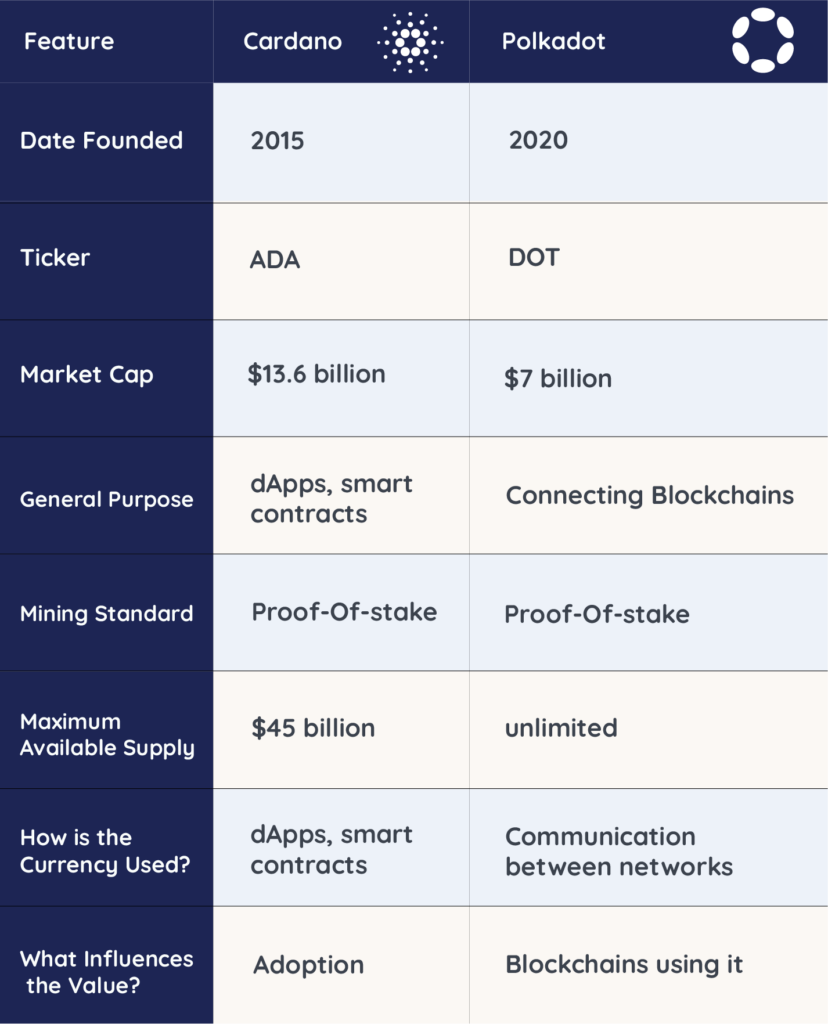Polkadot and Cardano are prominent blockchain protocols with unique features designed to address problems faced by legacy blockchain systems. Both share a common goal and have distinct ways to achieve that goal.
Polkadot offers users and projects infinite scalability and sustainability, supporting multiple smaller blockchains. On the other hand, Cardano prioritizes quick transactions and low fees.
Polkadot vs. Cardano: An Ethereum Alternative?
Polkadot is a protocol designed to connect multiple blockchains, enabling the transfer of data or value across previously siloed or incompatible networks. The protocol is quick and infinitely scalable, allowing unrelated blockchains to communicate with one another in a secure environment. It is widely regarded as one of the most successful projects currently working to improve dApps. Polkadot allows blockchains with vastly different infrastructures to interact with one another through parachains.
Parachains are specialized blockchains, each having its own token and functionality. The Polkadot blockchain uses a variation of the Proof-of-Stake consensus mechanism called Nominated Proof-of-Stake to select network validators. Its native token, DOT, is used for governance and staking purposes and is the driving force of the ecosystem. As a governance token, DOT allows token holders to have a say in the future and the functioning of the Polkadot platform. Staking allows the Polkadot Network to verify transactions and ensure the integrity of the ecosystem.
On the other hand, Cardano is a third-generation blockchain that aims to address problems such as scalability, high fees, and security, which are commonly faced by legacy blockchains such as Bitcoin and Ethereum. The team behind Cardano often calls the project an updated version of Ethereum, positioning it as an alternative to the smart contract platform. The protocol aims to create an evolved ecosystem for decentralized applications with multiple use cases and verifiable smart contracts.
Polkadot vs. Cardano: Architecture
Polkadot’s primary chain is called the Relay Chain, which hosts all the validators in the Polkadot ecosystem. The smaller chains, called Parachains, use collators who are tasked with constructing and proposing blocks to validators. Collators can submit a single parachain block for every Relay Chain block once every six seconds. When a block is submitted, it is checked by validators before it is committed to the Relay Chain.
Currently, Polkadot has a limited number of parachain slots. Projects or developers who want a parachain slot must participate in an auction. Each parachain slot can be reserved for up to two years.
Cardano’s blockchain architecture consists of two layers: the Cardano Settlement Layer (CSL) and the Cardano Computational Layer (CCL). The CSL is where peer-to-peer transactions occur. This layer uses the Plutus and Marlowe scripting languages to facilitate the value transfer. Cardano also uses a unique consensus mechanism called Ouroboros.
The Cardano Computational Layer replicates the concept of “Rootstock” from the Bitcoin ecosystem and focuses on scaling specific protocols. The CSL and CCL are independent, allowing smart contracts to function and execute without transaction verification constraints.
Polkadot vs. Cardano: Key Differences
While Polkadot and Cardano are two of the most popular protocols in the crypto space, they differ in key areas. For example, Polkadot emphasizes adaptability and practicality in development. As a Layer0 blockchain, it helps connect Layer1 blockchains with one another and acts as a foundation for other projects to build and operate upon. Cardano takes a rigorous and scientific approach to its development. Each upgrade on the network is peer-reviewed by experts. This approach ensures a robust and highly secure ecosystem.
Polkadot’s architecture centers around the Relay Chain, which facilitates communication between smaller blockchains (parachains). Applications on Polkadot enjoy a significantly higher level of interoperability than other networks, even Cardano. Meanwhile, Cardano’s architecture clearly defines the settlement layer from the computational layer. All transactions occur on the settlement layer, while smart contracts are executed on the computational layer.
DOT and ADA are Polkadot’s and Cardano’s native tokens, respectively. Both have similar utilities, primarily securing the network and paying transaction fees.
Polkadot vs. Cardano: Final Verdict
Comparing Polkadot and Cardano is like comparing apples with oranges. Polkadot acts as a foundational network, allowing other blockchains to build on top of it and communicate with one another. Meanwhile, Cardano is a Layer1 blockchain with its own ecosystem of tools, services, and dApps.
Disclaimer: This article is provided for informational purposes only. It is not offered or intended to be used as legal, tax, investment, financial, or other advice.





